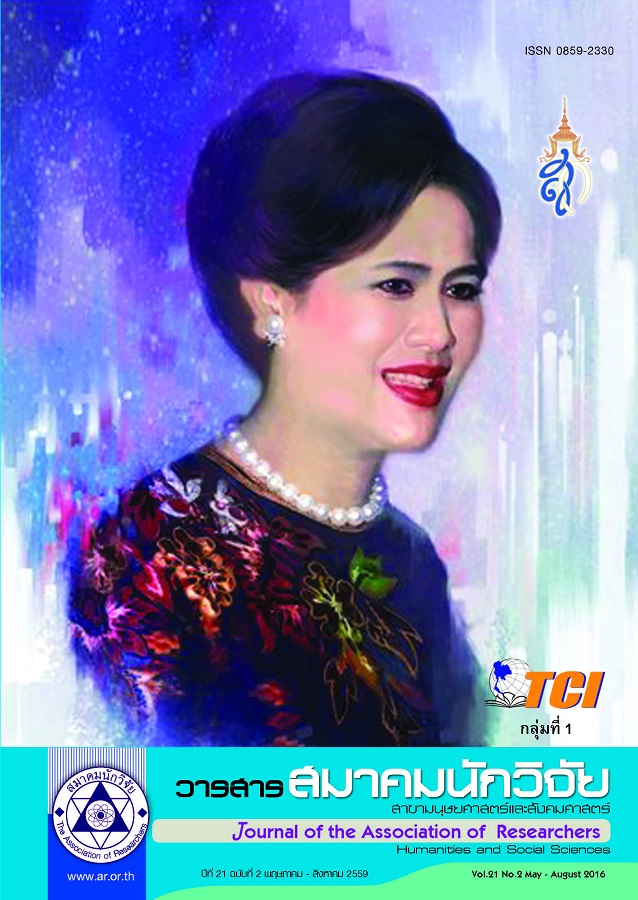Influences of Socially Responsible Leadership and Stakeholders’ Perception of Corporate Social Responsibility on Corporate Image of Chiang Mai International Airport
Main Article Content
Abstract
The objectives of this research were 1) to study the relationship among socially responsible leadership, stakeholders’ perception of corporate social responsibility and corporate image of Chiang Mai International Airport, 2) to study the influence of socially responsible leadership on corporate image of Chiang Mai International Airport, and 3) to study the influence of socially responsible leader and stakeholders’ perception of corporate social responsibility on corporate image of Chiang MaiInternational Airport. Sample was Chiang Mai International Airport’s stakeholders. Quota and judgmental sampling was applied, and completely sample size was 400. The results found that correlation coefficient among observable variables were 0.535-0.936 and had a significant level at every variables. From structural equation modeling found that socially responsible leadership had significantly influence on stakeholders’ perception of corporate socialresponsibility and the variance predicted by socially responsible leadership at 54.9 percent. Moreover, socially responsible leadership had significantly influence on corporate image and had indirect effect via stakeholders’ perception of corporate social responsibility and variance predicted to corporate image at 90.7 percent. Finally, stakeholders’ perception of corporate social responsibility had direct effect to corporate image. Fit indices of the model were χ2/df = 3.435; CFI = 0.992; NNFI = 0.988; RMSEA = 0.074 and 90% CI for RMSEA = 0.058.
Article Details
บทความที่ปรากฏในวารสารนี้ เป็นความรับผิดชอบของผู้เขียน ซึ่งสมาคมนักวิจัยไม่จำเป็นต้องเห็นด้วยเสมอไป การนำเสนอผลงานวิจัยและบทความในวารสารนี้ไปเผยแพร่สามารถกระทำได้ โดยระบุแหล่งอ้างอิงจาก "วารสารสมาคมนักวิจัย"
References
พิพัฒน์ นนทนาธรณ์. (2558ก). ปัจจัยเชิงสาเหตุของภาวะผู้นำที่รับผิดชอบต่อสังคมที่มีอิทธิพลต่อภาพลักษณ์องค์การ ของท่าอากาศยานสุวรรณภูมิ. วารสารสมาคมนักวิจัย. 20(2), 48-58.
_____ (2558ข). ภาวะผู้นำเชิงปฏิบัติการ: LIFE Model. (พิมพ์ครั้งที่ 2). กรุงเทพฯ: ศูนย์ผู้นำธุรกิจเพื่อสังคม.
_____ (2558ค). อิทธิพลของภาวะผู้นำที่รับผิดชอบต่อสังคมและพฤติกรรมการเป็นสมาชิกที่ดีขององค์การที่ส่งผลต่อ การมีส่วนร่วมในกิจกรรมด้านความรับผิดชอบต่อสังคมของพนักงานธนาคารออมสิน. วารสารสมาคมนักวิจัย. 20(3), 61-71.
_____ (2559). การจัดการความรับผิดชอบต่อสังคมขององค์การ: การสร้างข้อได้เปรียบในการแข่งขันอย่างยั่งยืน. (พิมพ์ครั้งที่ 2). กรุงเทพฯ: ศูนย์ผู้นำธุรกิจเพื่อสังคม.
References
Carroll, Archie (Ed.). (1977). Managing Corporate Social Responsibility. Boston: Little, Brown and Company.
Carroll, Archie B. and Ann K. Buchholtz, (2006), Business and Society (6th ed.). USA: Thomson South-Western.
Cheney, G., & Vibbert, S. L. (1987). Corporate Discourse: Public relations and issue management. In F. M. Jablin, L. L. Putnam, K. H. Roberts, & L. W. Porter (Eds.), Handbook of Organizational Communication: An Interdisciplinary Perspective. 165-194. Newbury Park, CA: Sage.
Diamantopoulos, A., & Siguaw, J. A. (2000). Introducing LISREL: A Guide for the Uninitiated. Thousand Oaks, CA: Sage.
Dutton, J. E., & Dukerich, J. M. (1991). Keeping an eye on the mirror: Image and identity in organizational adaptation. Academy of Management Journal, 34(3), 517-554.
Dutton, J., E., Dukerich, J. M., & Harquail, C. V. (1994). Organizational images and member identification. Administrative Science Quarterly, 39, 239-263.
Hooper, Daire, Joseph Coughlan & Michael R. Mullen. (2008). Structural Equation Modeling: Guidelines for Determining Model Fit. Electronic Journal of Business Research Methods, 6 (1), 53 – 60.
Kotler, Philip, and Nancy Lee. (2005). Corporate Social Responsibility. New Jersey: John Wiley & Sons.
_____ (2009). Up and Out of Poverty: The Social Marketing Solution. Upper Saddle River: Wharton School.
Leech, N. L., Barrett, K. C., & Morgan, G. A. (2005). SPSS for Intermediate Statistics: Use and Interpretation (2nd ed.). Mahwah, NJ: Lawrence Erlbaum Associates.
Moffitt, M. A. (1994). Collapsing and integrating concepts of ‘public’ and ‘image’ into a new theory. Public Relations Review, 20(2), 159-170.


